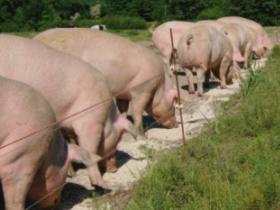Research: Effect of ensiling grains for pig nutrition

German research studied the effect of ensiling triticale, barley and wheat grains at different moisture content and addition of Lactobacillus plantarum (DSMZ 8866 and 8862) on fermentation characteristics and nutrient digestibility in pigs.
The ensiling characteristics of barley, triticale and wheat grains at two different moisture levels, with and without the addition of lactic acid bacteria (LAB, Lactobacillus plantarum DSMZ 8862 and 8866) were determined after a 50-day storage period.
In addition, the impact of the different ensiling techniques on the nutritional value was determined in pigs.
In Experiment 1, mature grains were ground and water was added to adjust the moisture to 250 g/kg (low moisture content, LMC) or 350 g/kg (high moisture content, HMC).
Grains were ensiled in laboratory scale silos for 3, 10 and 50 days.
Results
In the HMC silos, pH declined within 3 days irrespective of LAB treatment.
In the LAB treated LMC, pH declined after 10 days of storage, whereas pH of untreated grains remained unchanged.
Lactic acid production was higher in HMC than in LMC grains, with almost no acid production with the untreated LMC grains.
Denaturing gradient gel electrophoresis analysis revealed that the composition of the bacterial communities changed when LAB was added.
Nutrient digestibility of HMC and LMC grains ensiled for 50 days with addition of LAB and untreated dry grains was determined separately for each grain in pigs.
Digestibility was increased in LMC (crude fibre, crude protein, phosphorus) and HMC (ether extract) wheat grains, whereas only ether extract digestibility was improved in HMC triticale and no differences were observed for barley.
A higher phosphorus digestibility was observed in LMC triticale and wheat as compared to the dry grains, likely due to reduced phytate-P after ensiling.
Conclusion
The results show that cereals with a moisture content of 250 g kg−1 can be ensiled successfully provided that LAB is added, and that under these conditions phosphorus availability is increased.
References and further reading may be available for this article. To view references and further reading you must purchase this article.











